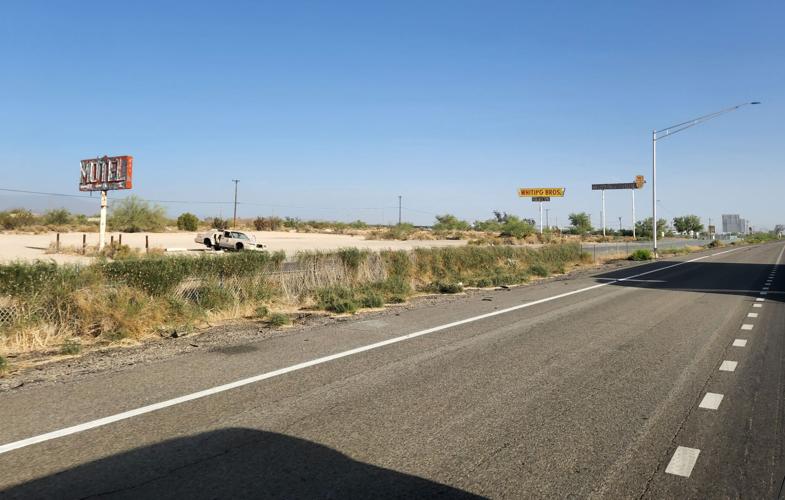Mohave County is known as the second-highest gold producing county in Arizona, behind Yavapai County.
Mohave was also a producer of tungsten along with other notable minerals such as copper, zinc and lead.

Bright green antlerite crystals up to 5mm from the Chuquicamata Mine, Chuquicamata District, Calama, El Loa Province, Antofagasta Region, Chile
Founded in 1864, Mohave County has a history influenced by the Colorado River, the railroad and the mining industry.
It was the Colorado River that the Mohave people settled upon, communicating with the Yuman dialect. The term Mohave in their language represents “three mountains,” having been derived from the words hamol, meaning “three,” and avi meaning “mountains”.
During the 1860s, the area saw increased population after the U.S. acquired the land from Mexico with the Treaty of Guadalupe Hidalgo in 1848.
Soldiers from the recently established Fort Mohave prospected the area, discovering gold east in the Cerbat Mountains.
One of the early trading centers along the Colorado River was established by William H. Hardy, which included a ferry crossing along with a town christened Hardyville, a prominent point of overland shipping for mining operations east of the Colorado.
By 1883 the Atlantic and Pacific Railroad had arrived with a railroad bridge erected across the Colorado River at Needles negating the once prominent Hardyville.
Kingman, founded as a railroad town in the 1880s and named for Lewis Kingman, the locating engineer for the Atlantic and Pacific Railroad, became the county seat for Mohave County in 1887.
Yucca, a railroad town 24 miles south of Kingman, served as an order office and water fill station for the Atlantic and Pacific Railroad, known later as the Atchison, Topeka and Santa Fe Railway that merged with the Burlington Railroad in 1995 and became the Burlington Northern and Santa Fe Railway.

Remnants of the once thriving business section in the town of Yucca.
Located on the western foothills of the Hualapai Mountains in the Cedar Valley Mining district in Mohave County, 12 miles east of Yucca off the Boriana Canyon Road, the Antler Mine was first discovered in the 1870s and patented before 1900. It produced zinc, copper and lead.
Early production records are scarce. However, the mine was once owned by Phelps-Dodge, which during World War I reported a shipment of 27 cars of oxidized copper ore assaying at up to 12% copper.
The property was worked by F.F. Hintze of Salt Lake City during World War II. Hintze is credited with having formed the Arizona Antlers Mining Co., which sunk a 243-foot shaft on the property. The geology of the mine site is primarily granite, part of a massive sulfide orebody of volcanic origin. By 1948, the Yucca Mining & Milling Co. acquired the property, constructing a mill with a capacity of processing 135 tons of ore per day.
Water was pumped in from a variety of sources including the Boriana Well, which held an open hole storage of 260,000 gallons. This water source also supplies the Boriana Mine located 4 miles from the Antler deposit. The mine operated a 300 ton per day mill.
By 1970 the mine had produced 80,000 tons of ore with a grade of 3% copper and 7% zinc, with 33,000 tons of ore milled that year by the Standard Metal Corp.
Interest in the mineral resources found at the Antler Mine continues at present with the exploration and redevelopment investment by New World Resources Limited.
Considered to be one of the highest grade copper deposits in the world, the Antler Mine comprises more than 6,600 feet of drifts on eight underground levels with access by a 650 foot deep shaft.

Old highway map depicting localities of the Antler Mine in relation to the town of Yucca.
The mine is the source for a rare secondary mineral known as “antlerite” that forms in the oxidized zone of copper deposits. Frequently confused with the brochantite it resembles, this Arizona type mineral is sometimes called “green vitriol” and was noted by W.F. Hillebrand in 1889 as a new species appearing as tabular, acicular or fibrous crystals.
The nearby Boriana Mine, a tungsten producer since 1908, became the largest producer of tungsten in Arizona and the second largest in the United States. Economic minerals at the mine include wolframite, scheelite and molybdenite in narrow quartz veins following the foliation of an elongate roof pendant of phyllite in granite. Copper, gold, silver, fluorite and beryl were other minerals found at the mine. Processing included a 200-ton combination gravity and flotation mill which produced tungsten concentrate.
Challenges in production history included finding sufficient skilled labor and upfront capital to fund the mining operations, which was a major issue during World War II. Water was supplied from underground workings including thousands of feet of underground drifts, winzes and raises.

Wolframite and Scheelite from the Boriana Mines.
Key production years for the Boriana ran from 1915 to 1943 and again from 1951 to 1956 wherein 149,000 tons of tungsten trioxide (WO3) were produced. Most of the accessible ore had been mined, however; the mine dumps were reworked in 1978 yielding an additional tonnage of ore.
The unstable character of the rock and flooding of the lower levels impeded further development and production.

Map depicting the location of the Boriana Mine.










